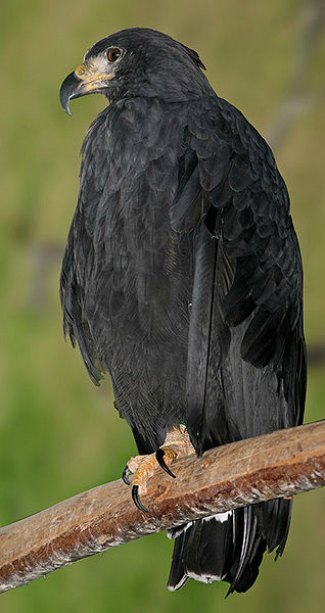Black Solitary Eagle - Harpyhaliaetus solitarius
By www.birdphotos.com, CC-BY-3.0, via Wikimedia Commons
Family: Accipitridae
Genus: Harpyhaliaetus
Species: H. solitarius
Subspecies: H. s. sheffleri, H. s. solitarius
Black Solitary Eagles are large, dark gray raptors that live in North, Central, and South America. They are closely related to Harpyhaliaetus coronatus (Crowned Solitary Eagle) and hawk genus Buteogallus.
Physical Description:
Black Solitary Eagles are entirely dark gray, except for the tail which has a white central band and a white tip. Females have a browner tinge than males and both sexes have a small, barely-visible crest. The eyes are yellowish-brown and the cere and legs are yellow. Subspecies H. s. shlefferi is larger and blacker than the nominate subspecies H. s. solitarius.
Adults closely resemble Buteogallus urubitinga (Great Black Hawk) and Buteogallus anthracinus (Common Black Hawk), but they are larger than the two hawk species, and B. urubitinga has lighter plumage.
Juveniles are similar to adults, though they have rufous edges, streaking along the crown, cheeks, and nape, black stripes around the eyes, and are black on the chest and thighs. Eyes are brown and the legs are greenish-white. They reach full adult plumage after three years.
Black Solitary Eagle calls are a series of short, shrill whistles. Listen to a recording.
Size:
Length: 65-75 cm
Wingspan: 157-180 cm
Weight: 3 kg
Habitat and Distribution:
They live at montane elevations from 600-2,200 meters above sea level in dense tropical and subtropical forest. They are rarely found in lowland areas.
They occur from northern Mexico and Central America to South America east of the Andes in northern Argentina, and their total range spans 28°N to 24°S. Adults are irruptive or local migrants. There are an estimated 250-999 individuals across 699,000 km².
Diet and Hunting:
The majority of their diet is snakes, though the remains of a chachalaca (a bird) were found in one of their nests.
Reproduction:
The breeding season begins in April in western Mexico.
The nest is built out of branches and lined with small sticks and green leaves. One of three observed nests was placed 27 m high in a pine tree and another was found in a fig tree at the bottom of a canyon. Both nests had only one nestling or egg. The single recorded egg was dull white and pitted, 75.71 by 57.45 mm in size. A third nest was found on June 30, 2011 by Roni Martinez of the Belize Raptor Research Institute and Matt Allhouse, Stacia Novy, and Audrey Martin of the Peregrine Fund.
Conservation:
Little is known about their conservation status. They are possibly under threat from habitat loss, pesticide use, and shooting, but they can be confused with Buteogallus urubitinga (Great Black Hawk) in the field, thereby muddling data collected. They are currently listed as Near Threatened by BirdLife International.
Conservation measures proposed include studies into their ability to survive in fragmented and degraded habitats, conducting surveys to determine their population size, and expanding protected areas.
Taxonomy:
Harpyhaliaetus solitarius was formerly classified as a subspecies of Harpyhaliaetus coronatus (Crowned Solitary Eagle), but molecular evidence has shown that while they are, in fact, related, they are not as closely related to be considered the same species. Both Harpyhaliaetus species are related to the hawk genus Buteogallus, more so than to other eagle genera such as Aquila, Harpia, and Spizaetus.
Subspecies:
There are two subspecies: H. s. sheffleri is found in western Mexico, and H. s. solitarius is found in northeastern Mexico and Central America south to Venezuela, Colombia, Ecuador, Peru, Bolivia, Paraguay, and northwestern Argentina.
Subspecies H. s. sheffleri was named after W. J. Sheffler, who discovered the nest of a Black Solitary Eagle in 1947.
Other Names:
Montane Solitary Eagle, Solitary Eagle, Eremitørn (Danish), Amerikaanse Zwarte Arend (Dutch), Erakkohaukka (Finnish), Buse solitaire (French), Einsiedleradler (German), Aquila solitaria nera (Italian), Ogurokammurinosuri (Japanese) Tåkevåk (Norwegian), Harpijnik ciemny (Polish), Águila Solitaria (Spanish), Svart eremitørn (Swedish).
Video of a Black Solitary Eagle:
References:
http://avibase.bsc-eoc.org/species.jsp?avibaseid=5C9AF2BEB3ADDAC6
BirdLife International (2012) Species factsheet: Harpyhaliaetus solitarius. Downloaded from
http://www.birdlife.org on 26/02/2012.
http://www.coppolaresorts.com/about-us/news/2011/07/blancaneaux-conservation-officer-finds-nest-of-the-rare-solitary-eagle-in-the-mountain-pine-ridge
http://elibrary.unm.edu/sora/Condor/files/issues/v079n01/p0132-p0133.pdf
Global Raptor Information Network. 2012. Species account: Black Solitary Eagle Harpyhaliaetus solitarius. Downloaded from
http://www.globalraptors.org on 26 Feb. 2012
http://ibc.lynxeds.com/species/black-solitary-eagle-harpyhaliaetus-solitarius
http://www.itis.gov/servlet/SingleRpt/SingleRpt?search_topic=TSN&search_value=175548
